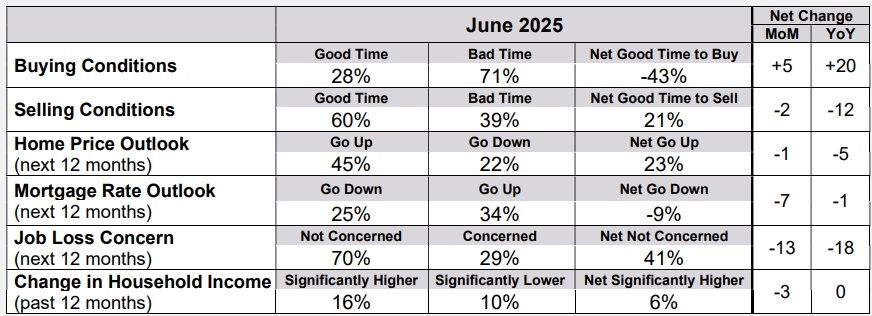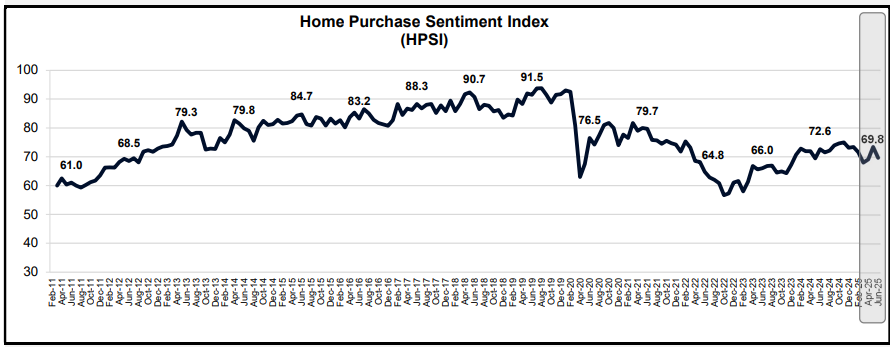Fannie Mae has published the results of its June 2025 National Housing Survey (NHS), which includes the Home Purchase Sentiment Index (HPSI), a measure of consumer sentiment toward housing. Month-over-month, Fannie Mae’s HPSI decreased 3.7 points to 69.8, and year-over-year, the HPSI is down 2.8 points.
For the study, Fannie Mae factors in six HPSI components—Buying Conditions; Selling Conditions; Home Price Outlook (next 12 months); Mortgage Rate Outlook (next 12 months); Job Loss Concern (next 12 months); and Change in Household Income (past 12 months). Of the six, the only component to improve in June was Buying Conditions. The remaining five components reported declines.
“Driving this month’s bout of pessimism were a sharp increase in job loss concern and continued uncertainty surrounding the future of mortgage rates,” said Joel Berner, Senior Economist at Realtor.com. “The lone bright spot in the survey results came from prospective buyers starting to recognize the softness in the market at large and responding positively to the question about now being a good time to buy.”

Of those polled, 28% said it was a “Good Time” to buy a home, while 71% felt it was a “Bad Time” to buy a home. The net share of consumers (-43%) who say it is a good time to buy a home increased five percentage points since last month. The share who says it is a good time to buy increased two percentage points (28%), while the share who say it is a bad time to buy (71%) decreased three percentage points. The net share of consumers who say it is a good time to sell decreased two percentage points month-over-month to 21%. Most consumers (60%) say it’s a good time to sell, while 39% say it is a bad time to sell.

Trends Follow Trends
After a strong rebound in May, consumer confidence fell in June, as consumers remain concerned about the economy and labor market amid ongoing uncertainty, especially around tariffs. This month’s decline erased almost half of last month’s sharp gain, suggesting continued volatility in consumer sentiment.
As reported by the Conference Board, the Consumer Confidence Index, a measure of how optimistic or pessimistic consumers feel about their financial situation, fell from 98.4 to 93 in June 2025—the second lowest level reported since February 2021.
Consumers’ assessment of current business conditions turned negative in June. Respondents rating business conditions as “good” decreased by 2.4 percentage points to 19%, while those claiming business conditions as “bad” rose by 1.6 percentage points to 15.3%.
“Consumer confidence weakened in June, erasing almost half of May’s sharp gains,” said Dr. Stephanie Guichard, Senior Economist, Global Indicators at The Conference Board. “The decline was broad-based across components, with consumers’ assessments of the present situation and their expectations for the future both contributing to the deterioration. Consumers were less positive about current business conditions than May. Their appraisal of current job availability weakened for the sixth consecutive month but remained in positive territory, in line with the still-solid labor market. The three components of the Expectations Index—business conditions, employment prospects, and future income—all weakened. Consumers were more pessimistic about business conditions and job availability over the next six months, and optimism about future income prospects eroded slightly.”
The Conference Board reported on consumers’ plans to buy a home within six months. Those planning to buy a home fell slightly to 5.9% in June. Of those, respondents planning to buy a newly constructed home decreased to 0.2%, and those planning to buy an existing home dropped to 3.2%. The remaining 2% were planning to buy a home, but were undecided between new or existing homes.
The state of tariffs remains key for many as they begin to feel the economic pressure of the Trump administration-imposed actions.
“Tariffs remained on top of consumers’ minds and were frequently associated with concerns about their negative impacts on the economy and prices,” added Dr. Guichard. “Inflation and high prices were another important concern cited by consumers in June. However, there were a few more mentions of easing inflation compared to last month. This is in line with a cooling in consumers’ average 12-month inflation expectations to 6.0% (down from 6.4% in May and 7% in April). References to geopolitics and social unrest increased slightly from previous months but remained much lower on the list of topics affecting consumers’ views.”
Builder Confidence Wanes
As buyers and sellers struggle with market conditions, builder confidence in the market for newly built single-family homes was 32 in June, down two points from May, according to the National Association of Home Builders (NAHB)/Wells Fargo Housing Market Index (HMI). The Index has only posted a lower reading twice since 2012–in December 2022 when it hit 31 and in April 2020 at the start of the pandemic when it plunged more than 40 points to 30.
“Buyers are increasingly moving to the sidelines due to elevated mortgage rates and tariff and economic uncertainty,” said NAHB Chairman Buddy Hughes, a Home Builder and Developer from Lexington, North Carolina. “To help address affordability concerns and bring hesitant buyers off the fence, a growing number of builders are moving to cut prices.”
The latest HMI survey also revealed that 37% of builders reported cutting prices in June, the highest percentage since NAHB began tracking this figure on a monthly basis in 2022. This compares with 34% of builders who reported cutting prices in May and 29% in April. Meanwhile, the average price reduction was 5% in June, the same as it has been every month since last November.
“Rising inventory levels and prospective home buyers who are on hold waiting for affordability conditions to improve are resulting in weakening price growth in most markets and generating price declines for resales in a growing number of markets,” said NAHB Chief Economist Robert Dietz. “Given current market conditions, NAHB is forecasting a decline in single-family starts for 2025.”
Click here for more on Fannie Mae’s Home Purchase Sentiment Index for June 2025.
The post Employment Concerns Driving Down Home Purchase Sentiment first appeared on The MortgagePoint.























